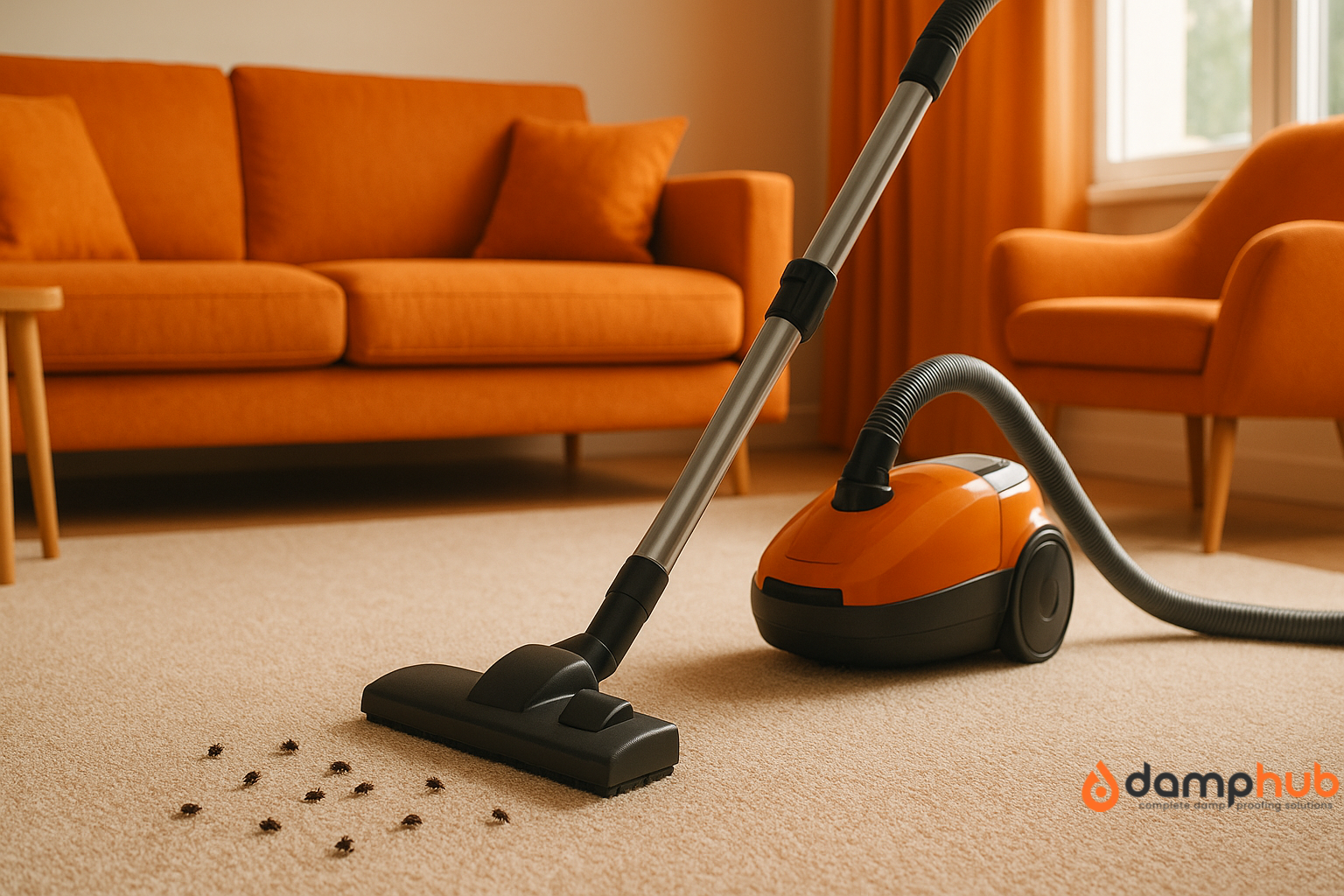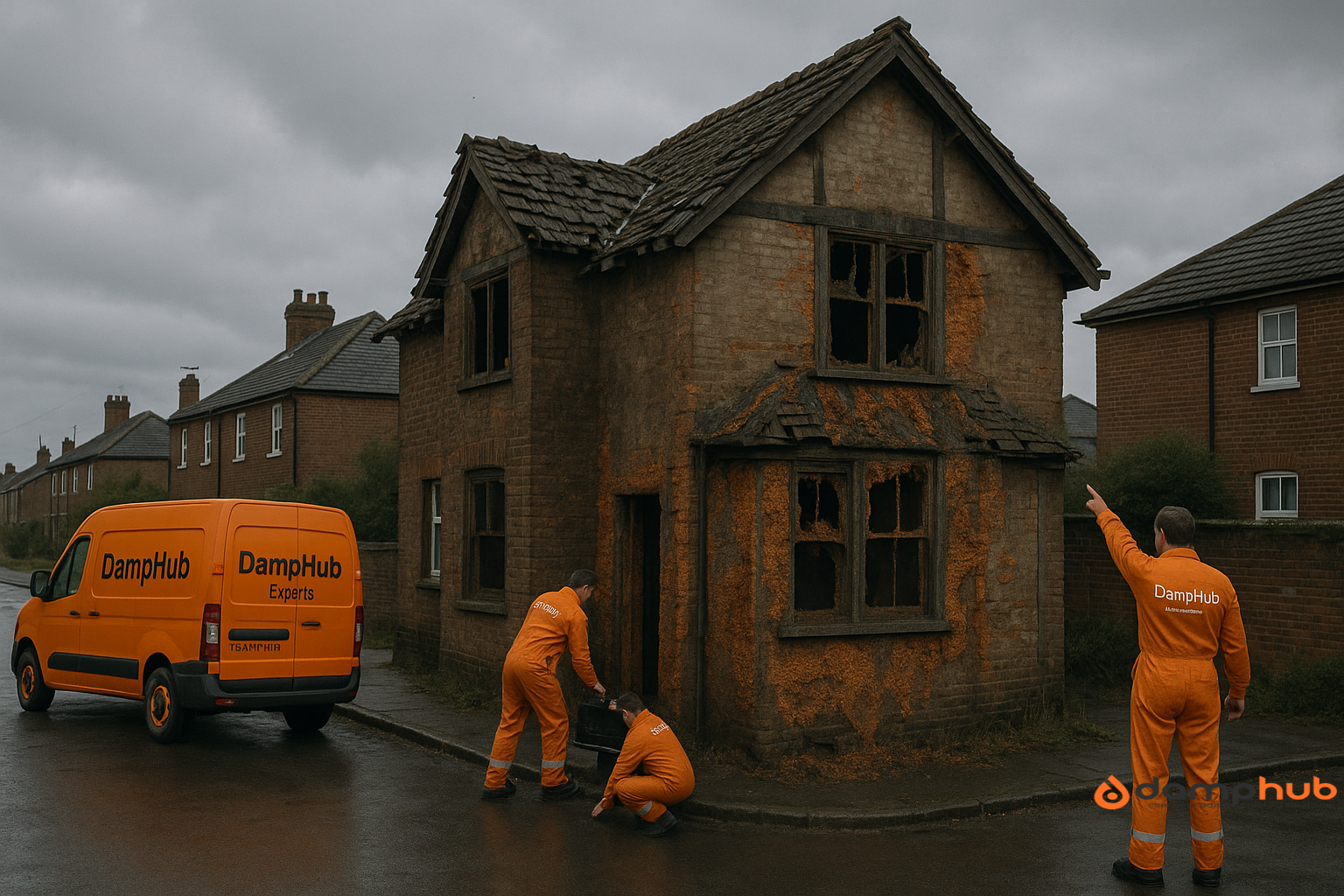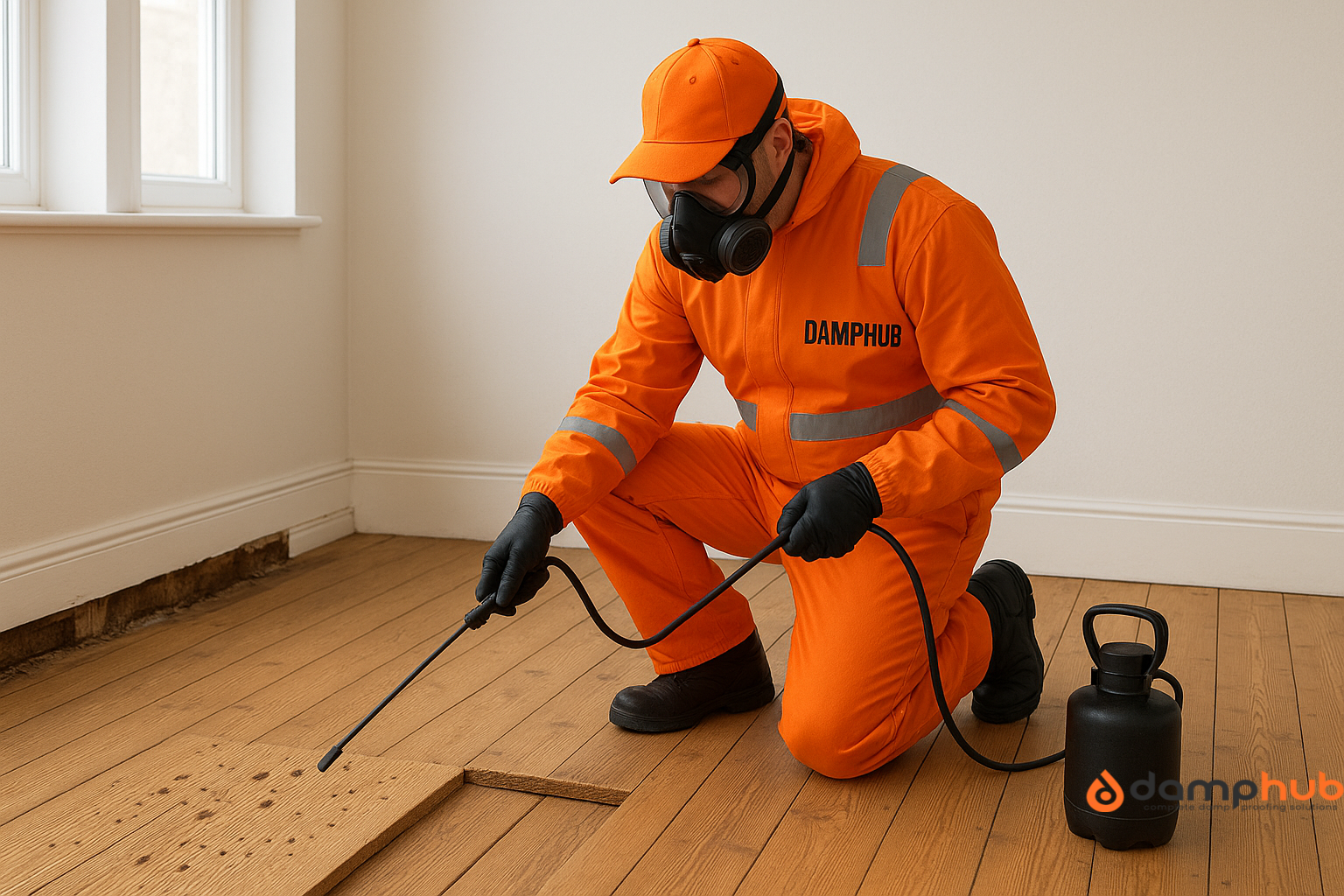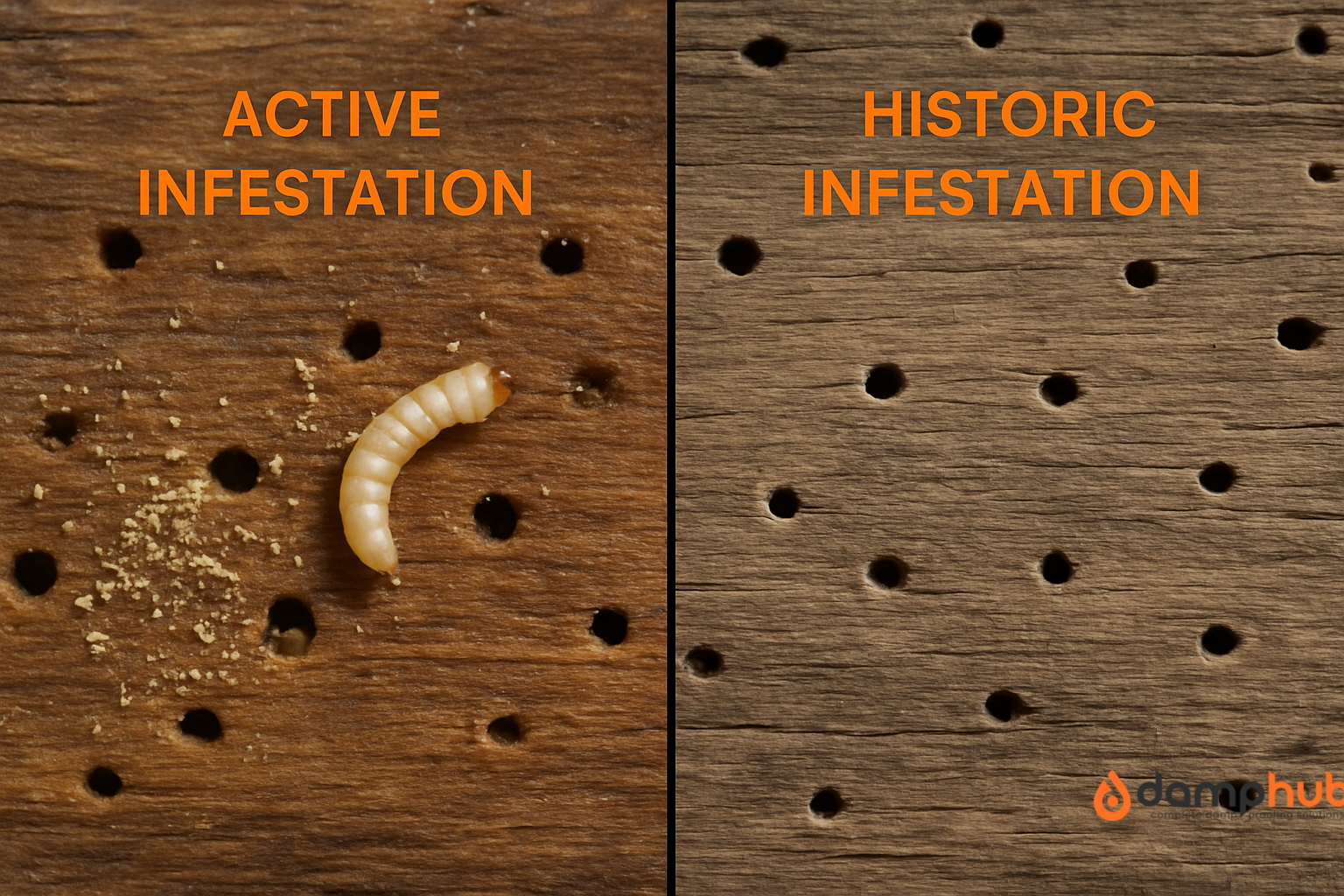
You may not hear them. You may not see them. But woodworm could be quietly eating through the timber in your home right now.
These insects often stay hidden in loft beams, under stairs, or inside old furniture, where they cause damage without you knowing.
You usually only discover an active woodworm infestation once the signs start to show. Maybe a floorboard feels soft underfoot. A stair tread gives way. Or a chair leg suddenly cracks. By that point, the damage is already done, and the repair costs are mounting.
If that’s something you’d rather avoid, this guide is for you. You’ll learn how to spot the early signs of woodworm and what to do before it spreads any further. Let’s get started.
What is Active And Inactive Woodworm Infestation?
An active infestation means the woodworm (actually beetle larvae) are still alive and feeding inside your wood right now. They’re tunnelling through the timber, weakening it from the inside out.
An inactive infestation means the woodworms were there in the past, but they’ve long since matured, left the wood, and died. The damage remains, but it’s not getting worse.
Active vs Inactive Woodworm Infestations Comparison Table
Active vs Inactive Woodworm Infestation
| Feature | Active Infestation | Inactive Infestation |
|---|---|---|
| Beetle Larvae | Alive and feeding inside the wood | Gone — they’ve matured and exited |
| New Exit Holes | Fresh-looking holes with sharp, pale edges | Old holes with worn, darkened edges |
| Wood Dust (Frass) | Fine, light-colored dust near or under holes — a clear sign of recent activity | No dust present — nothing is boring through the wood anymore |
| Timber Condition | Feels soft, flaky, or weak when pressed | Feels dry and solid |
| Beetle Sightings | You may spot live beetles emerging (especially in spring or summer) | No beetles around |
| Noise or Movement | In rare cases, light tapping may reveal hollow spots or even quiet internal noise | No signs of movement or hollow-sounding wood |
| Time of Year | More likely to notice signs during warm months (May–September) | No seasonal changes |
| Urgency | High — immediate action needed to prevent structural damage | Low — monitor, but treatment often not required if no signs of activity |
How Does a Woodworm Infestation Start?
It starts with a beetle. An adult female finds a piece of timber she likes — usually slightly damp and soft enough for her larvae to chew through. She lays her eggs in tiny cracks, under loose paint, or inside old exit holes.
When those eggs hatch, the larvae bore into the timber and start feeding. They live hidden inside the woods for years, slowly making their way deeper. You won’t see them. You won’t hear them. But they’re there, turning strong wood into a maze of tiny tunnels.
At some point — two, three, maybe even five years later — they’ll pupate and emerge as adult carpet beetles. That’s when you spot the round exit holes and the fine-bore dust called frass. But here’s the catch: if you’re seeing that now, it means they’ve already done years of work inside your wood.
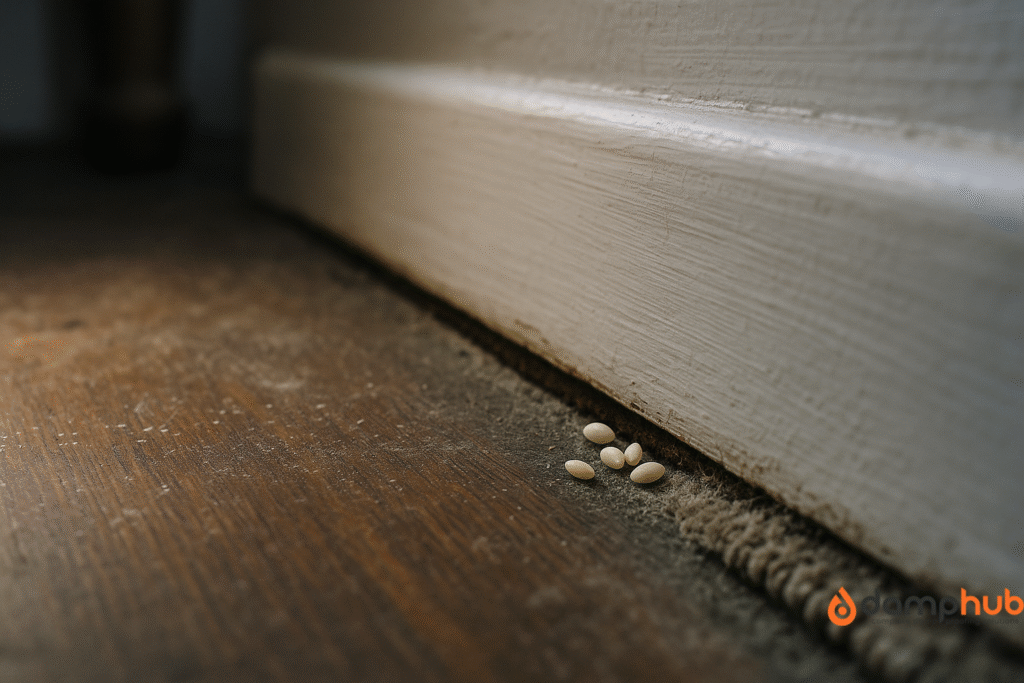
What Causes Woodworm Infestation?
There’s no single reason. It’s often a mix of conditions that make timber inviting:
- Damp timber — woodworm larvae love moisture. Leaky roofs, rising damp, or poor ventilation can make timber soft and appealing.
- Old or untreated wood — timber without a protective treatment is easier to chew through. Antique furniture is a classic target.
- Poor airflow — lofts, cellars, and crawl spaces often trap damp air.
- Previous infestation sites — old exit holes can be reused by beetles for laying new eggs.
- Second‑hand timber or furniture — woodworm can hitch a ride straight into your home from somewhere else.
Moisture is often the deciding factor. In a dry, well‑ventilated home, woodworm infestation is far less likely. But give them damp timber, and they settle in for the long haul.
Where Does Woodworm Infestation Occur?
Woodworm will take just about any piece of timber it can get into, but in UK homes, there are a few favourite spots.
- Roof timbers – Lofts often have poor ventilation. A slipped tile or small leak is all it takes to let in damp, and that’s an open invitation.
- Floorboards and joists – Especially on ground floors, where air circulation is poor. Moisture rising from the soil can keep timber slightly damp for years.
- Furniture – Antique or second‑hand furniture is a classic carrier. Sometimes you bring the problem in without knowing it.
- Staircases and banisters – These are often overlooked until the damage is advanced.
- Door and window frames – Condensation or water ingress around these can keep the wood soft.
Good to Know
In many cases, the infestation is localised. One beam might be riddled while the one next to it is untouched. This is why a close inspection is vital — you can’t assume every piece of timber in the area is affected.
Which Homes are at Risk of Woodworm Infestation?
You might think woodworm only affects old cottages with creaky floorboards, but that’s a myth. Modern houses aren’t immune. Any home with untreated or damp timber is at risk.
High‑risk situations include:
- Homes with poor ventilation, especially in lofts and under floors.
- Properties with ongoing damp problems.
- Houses with unheated rooms where condensation lingers.
- Storage of second‑hand furniture without inspection.
- Timber outbuildings or sheds in constant contact with damp ground.
Pro Tip
If you’re buying a property — especially an older one — always have a damp and timber survey carried out. It’s cheaper to know now than to find a hidden infestation after moving in.
Signs of Active Woodworm Infestation?
If you spotted signs of woodworm infestation in your property, here is how to tell if it’s an active or historic infestation:
- Fresh exit holes – Small, round holes (about 1–2 mm) with clean edges. The wood around them often looks lighter than the surrounding timber.
- Frass (bore dust) – Fine, powdery dust that falls from holes or sits on nearby surfaces. Fresh frass is loose and dry, not clumped or hard.

- Powder on the floor – Small piles of pale dust directly under a damaged beam or furniture leg are a giveaway.
- Weakened timber – Press the wood gently. If it crumbles or feels soft under light pressure, larvae may still be feeding inside.
- Live beetles – In summer months, you might spot them near windows or emerging from the timber.
- Hollow sound – Tap the timber lightly. If it sounds hollow, it may have been eaten away inside.
Pro Tip
Clean away frass and make a note of the spot, then check it again in a couple of weeks. If new dust appears, you’re likely dealing with an active woodworm infestation.
Good to Know
Old woodworm damage isn’t a problem on its own — the risk is when signs are fresh. Being able to tell the difference can save you from paying for treatment you don’t actually need.
How Serious Is an Active Woodworm Infestation?
Woodworm is a serious threat to your home’s structure. The larvae burrow deep into timber and feed on it for years. What may seem like a few harmless holes on the surface could mean the wood is crumbling inside. Floorboards can snap underfoot. Roof timbers can weaken. Joists and beams can become dangerously unstable.
In older homes, where timber plays a major structural role, an untreated infestation can lead to full structural failure. This is not a problem you can afford to leave. It only gets worse with time and increase woodworm treatment costs.
Good to Know
Even if you only see damage in one spot, don’t assume the rest is safe. Woodworm doesn’t always spread evenly. Have the whole area checked before deciding on treatment.
How to Treat Active Woodworm Infestation
Treatment depends on the extent of the infestation and where it is. Some small, surface‑level issues in furniture can be handled at home. Structural timber infestations almost always need professional treatment.
Home Remedies for Minor Cases
- Freezing small items – If the infested wood is portable and small enough (like a chair or decorative item), wrapping it in plastic and freezing it for several days can kill larvae.
- Boron‑based treatments – Available at DIY stores, these penetrate timber and kill active larvae. They work best for light, accessible infestations.
- Heat treatment – For smaller pieces, heating the wood to around 55°C for an hour or more will kill larvae. This isn’t always practical for large items.
Professional Treatments
- Insecticidal sprays and gels – Applied by licensed professionals, these penetrate deep into the timber to kill larvae.
- Fumigation – For severe or widespread infestations, professionals may use gas or mist treatments to reach every part of the timber.
- Timber replacement – If the wood is badly weakened, it may need to be removed and replaced to restore strength.
How Long Does it Take to Treat Woodworm?
Small, isolated infestations in furniture can be dealt with in a matter of days. Freezing, heating, or applying a surface treatment works quickly once started.
For structural timber in a home, treatment can take longer. Sprays and gels work over several days to penetrate the wood and kill larvae. Fumigation or large‑scale treatments may require you to vacate the property for a short time.
The bigger factor is when you start. The sooner you treat an active woodworm infestation, the faster it’s resolved and the less damage you’ll face.
Wait too long, and the repair work becomes the slowest and most expensive part.
Pro Tip
Don’t delay arranging a survey. Even if you’re unsure, getting a professional opinion early is always cheaper than waiting for obvious structural damage.
How Can You Prevent Woodworm Infestation?
Prevention is always cheaper than treatment. And the good news? Most of it comes down to keeping your timber dry and well‑ventilated.
- Control moisture – Keep your home well‑ventilated, especially in lofts, basements, and under‑floor spaces. Fix leaks promptly.
- Treat vulnerable timber – Use a wood preservative on untreated timbers, especially in sheds, garages, or exposed areas.
- Inspect regularly – Check for holes, frass, and soft spots at least twice a year. Pay extra attention after damp winters.
- Check second‑hand furniture – Inspect before bringing it indoors. Look for exit holes and shake gently over a light surface to spot falling dust.
- Manage storage conditions – Avoid keeping wooden items directly on damp floors or pressed against cold external walls.
Pro Tip
If you’re storing wooden furniture in a loft or outbuilding, lift it off the floor and allow airflow all around it. This helps stop moisture from building up and attracting beetles.
Will Woodworm Infestation Come Back After Treatment?
If treatment is done properly, the chances are low — but not zero. Professional insecticidal treatments usually kill all active larvae in the treated timber, and reputable companies back their work with a guarantee.
That said, a new woodworm infestation can occur if conditions are still favourable. Damp timber, poor ventilation, and untreated wood can all invite beetles back over time. This is why prevention after treatment is just as important as the treatment itself.
What to Do if Woodworm Infestations Come Back?
If you spot fresh frass or new holes after DIY woodworm treatment, act quickly. Don’t assume it’s a leftover from before — confirm it.
- Re‑inspect – Look for multiple signs: fresh dust, clean‑edged holes, and soft timber.
- Contact the treatment provider – If your treatment came with a guarantee, they should return to re‑treat at no extra cost.
- Address the cause – Check for damp or poor ventilation and fix it to prevent a cycle of re‑infestation.
Pro Tip
Always keep your treatment paperwork. A guarantee is only useful if you can prove the work was done.
Final Thought
A woodworm infestation rarely starts with anything dramatic. It’s quiet, hidden, and easy to miss — until it isn’t. By the time the signs are obvious, a lot of the damage has already been done.
The best defence is a mix of awareness and action. Know where to look, check regularly, and deal with problems early. If you suspect an active infestation, confirm it quickly and treat it without delay.
Whether you tackle a small case yourself or bring in a professional for bigger jobs, the aim is the same: protect your timber now so you don’t face expensive repairs later.
Woodworm Infestation Question Answered

-
What do woodworms hate?
Woodworm larvae hate dry timber. They thrive in damp, slightly soft wood because it’s easier to chew through.
They also dislike treated wood — preservatives make it harder for them to survive. Keeping your timber dry and well‑ventilated is one of the best defences against a woodworm infestation.
-
What is a natural killer for woodworm?
Boron‑based solutions are one of the most effective natural treatments. They soak into the wood and kill active larvae without the harsh chemicals found in some insecticides.
For smaller, movable items, extreme heat or freezing can also kill woodworm naturally.
-
Can woodworm go away by itself?
Not really. Larvae live inside timber for years before emerging. Once they’re in there, they won’t just leave.
They keep feeding until their life cycle is complete. Without treatment, a woodworm infestation will keep damaging your wood until the larvae pupate and emerge — and even then, new beetles can start the cycle again.
-
How quickly do woodworms spread?
Woodworm don’t move fast like ants or termites, but the damage builds steadily.
A single lifecycle can last 2–5 years, during which the larvae are constantly feeding. If conditions stay the same, an infestation can slowly spread to nearby timber.
-
How to stop woodworm spreading?
Treat the affected timber as soon as you confirm activity. Isolate or remove heavily infested items if possible.
Reduce moisture levels and improve ventilation in the area. The aim is to make the environment less attractive so any surviving beetles can’t lay fresh eggs and start the cycle again.
-
Does boiling water kill woodworm?
In theory, yes — extreme heat kills woodworm larvae. But in practice, boiling water isn’t a realistic option for structural timber or furniture.
It can warp and damage the wood. Heat treatment works better when done in a controlled way, often by professionals.
-
Can woodworm infestations live in clothes?
Woodworm don’t feed on clothes, so they can’t survive in fabric the way moth larvae do. However, they can sometimes hitch a ride. If clothes have been stored in contact with infested timber, tiny larvae or eggs could cling on.
If those clothes are later kept somewhere with suitable wood — like a wooden wardrobe or beam — the infestation could spread. It’s rare, but it’s another good reason to check and clean anything stored near affected timber.
-
Can I ignore woodworm?
You could — but you’ll regret it. Ignoring an active woodworm infestation is like ignoring a slow leak in your roof.
It might not seem urgent today, but the damage will keep building until it’s expensive and disruptive to fix. Acting early is always the cheaper option.




